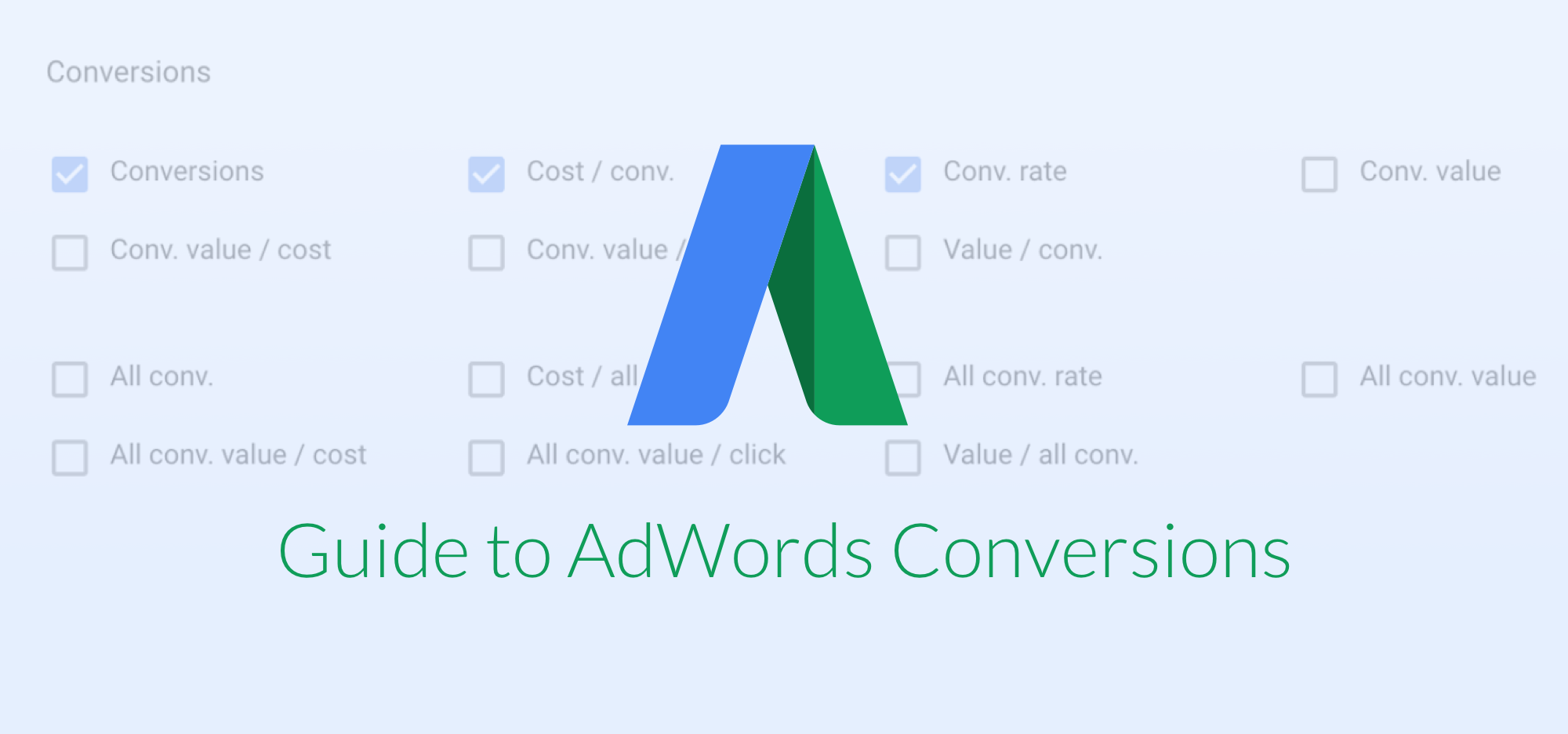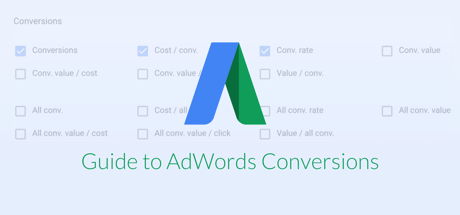
For anyone working in digital marketing, it can be a challenge to keep track of the multitude of AdWords conversions conversions from view through to call conversions. Metric names and definitions can change, appear and disappear periodically and the AdWords Help Center has a lot of content to sift through. Knowing how AdWords campaigns convert is an essential part of digital marketing. Along with retargeting, AdWords conversion metrics are one of the best ways of increasing overall conversions. In this post, we’ll try to bring some clarity by summarizing what we know about the conversions found in AdWords. On top of the metrics listed below, AdWords users can also define their own custom conversion events and actions. However, this post will focus on a group of selected standard conversion metrics available to all AdWords users.
Using AdWords Conversion Metrics
What actions can I track?
AdWords can help you follow your audience’s interactions with your advertising by following different types of actions that they take after being exposed to your ads. In order to start doing this, you need to set up conversion tracking in AdWords. When setting up conversion tracking, you will need to choose a conversion source for each new conversion you want to track. As you may have already noted, you can choose between four different conversion sources: Websites, Phones, Apps and Imports. Each of these will allow its own group of actions to be tracked.
-
Website actions
These include purchases, sign-ups and other actions that customers complete on your website. In this case, you will need to implement a tracking tag on your website. This will allow AdWords to make connections between users you have reached through advertising on their platform and visitors on your website.
-
Phone calls
Calls triggered directly from your ads, calls to a phone number displayed on your website and clicks on a phone number on the mobile version of your website. You can also import phone call conversions from an external source, such as a CRM. You can find more information about tracking phone call conversion in AdWords here.
-
App installs
App installs and in-app actions include installs of your Android or iOS mobile applications, as well as purchases and other standard or custom events/activities within those apps. Read more on setting up mobile app conversion tracking here.
-
Import
Importing customer activity that begins online but finishes or converts in an offline environment. An example of this could be a customer filling in a contact form online on your website, but later finalising a deal by signing a contract at physical office or subsidiary. Read up on offline conversion tracking and its benefits here.
All of these actions can be counted using one or more conversion metrics.
What metrics can I use?
The first set of conversion metrics are all interaction-based. This means that a customer is required to interact with one of your ads before completing a conversion in order for a conversion to be counted.
-
All conversions (All conv.)
This shows you data for all conversions actions, including those which you may have chosen to not include in the below Conversions metric. It includes conversions on your website, phone call conversions, cross-device conversions. Conversions from other special sources, such as conversions tracked in apps or imported from an external source, are also included.
-
Conversions
Conversions show you the number of conversions you have received across all your conversion actions. You can use this metric to see how often interactions with your digital ads lead customers to carry out actions that provide value to your business
-
Cross device conversion
Cross device conversion tracking shows the total number of modeled cross device conversions across all of your conversion actions. A cross-device conversion happens when a user clicks on your ad on one device and converts on another. -
Phone call conversions
Call conversions count the number of calls that originate from your call extensions and that last longer than a configured duration (this duration is customizable in AdWords).
NOTE: Imported conversions will be grouped under any of the above metrics depending on which original customer interaction they are associated with. When a customer converts offline, that event will need to be assigned a unique identifier that is identical to the “GCLID” of a click on one of you AdWords ads. The unique GCLID is provided for every click that comes to your website from an AdWords ad.
If we want to look at conversions that are attributed in other ways than the metrics we have discussed so far, look no further.
-
Click-assisted conversions
Click-assisted conversions counts all the conversions assisted by clicks on your ads, not taking into account the last click made before the conversion was completed. This lets you get an idea of how many of your conversions can be associated with clicks generated by your keywords, ad groups or campaigns.
-
Impression-assisted conversions
This metric reports the conversions that were assisted by impressions before the last click. This lets you get an idea of how many of your conversions can be associated with impressions generated by your keywords, ad groups or campaigns. -
View through conversions (View-through conv.)
View-through conversions track when customers see (but don’t interact) with your ad and later are tracked as generating a conversion on your website. This is different from the data in your other conversion columns, which require an interaction with one of your ads and then complete a conversion on your website in order to be recorded. The definition of a customer “seeing” an ad is that 50% of it should have been visible on the customer’s screen for at least 1 second.
Lastly, AdWords can show you how much conversion value it has provided you with, eg. how much revenue it has helped your business generate through the conversions you have driven by advertising through AdWords.
-
Total conversion value (Conv. value)
The sum of the value attributed to all your conversions. This is usually only useful if you have the means to pass along profit or revenue figures to AdWords using the conversion tracking implemented on your website (or wherever the conversion occurs).
What insights can I gain?
In order to grasp how your business is performing in a broader sense, All conversions is an appropriate metric to follow. Looking at this metric gives you the total number of conversions that all your AdWords advertising is driving, from last-click conversion on your website to offline conversions that happen as a consequence of an online interaction like a sign-up through a contact form. If you want to drill down a little further and break up the total number of conversions, you can do so using the Conversions, Cross device conversions and Phone call conversions metrics.
As an example, Cross device conversions are more suited to take modern online consumer behaviour into account. A user that becomes a customer may research products based on an ad they interacted with on their mobile device, but actually complete the conversion on their desktop computer. Digging into Phone call conversions can help you understand what degree of incoming calls end up generating a sale or contract, leading to refined messaging and more better budget allocation for the campaigns that get you the best offline results.
Click-assisted conversions and Impression-assisted conversions provide a way of going beyond last-click attribution when evaluating your AdWords advertising. These metrics may not account for a large portion of the optimization that you will do in AdWords, but they can help you determine if your campaigns, ads and keywords are creating a positive synergy amongst each other. Essentially, you may be running ads or bidding on keywords that are not directly driving your audience to conversions on your website, but still provide a beneficial effect to those that are. This becomes a way to see which of your AdWords marketing activities are helping out others.
View through conversions are a helpful way to track the impact of campaigns that are primarily meant to generate awareness through visibility, usually display or video ad campaigns. As already outlined, they measure the conversions where a customer saw but didn't interact with an ad before completing a conversion. View through conversions take into account the settings of your conversion actions, such as the way conversions are counted. Basically, they are the equivalent of your Conversions metrics, but where the interaction condition has been replaced by a “view” condition instead. Keep in mind that as View through conversions are recorded after a customer simply “viewed” an ad, these conversions could be attributed to other paid traffic sources entirely, or SEO and other organic channels, on a last-click basis.
If you need a way to understand how much revenue or profit your AdWords marketing has been involved in, you can use Total conversion value. Since this will include conversions of all types of attribution, you can expect overlap with other marketing channels and a higher number than whatever is shown in your system of record for sales data. However, it will still give you an idea of the impact of AdWords as a marketing channel is having on your business in a broad sense.
Conclusion
In order to know which metric or metrics to focus on when evaluating your AdWords marketing, you will need to think about the ways in which you can try to make your business more successful. What is the high-level perspective of how AdWords is driving audiences to your business and to what degree are they becoming customers? Are you tracking which of your incoming phone calls lead to a closed deal or purchase? Do you need to experiment with new keywords to bid on in order to broaden your top-of-funnel audience?
Depending on which of these questions you need to answer, different metrics will be more or less appropriate. If you have not yet set up any conversion tracking, or if you are missing conversions, the above information may provide some useful pointers and help inform your decisions. If you are already using AdWords conversions, we hope that this post can at least help clarify where to look for new insights and answers!
Whether you’re setting up Google Analytics for your ecommerce business, learning the basics of data aggregation, or more, Funnel has tons of useful info. Of course, our all-in-one marketing reporting platform is also a great tool for any digital marketer’s tool box.
Try this next: 9 effective tips for Google Ads optimization
